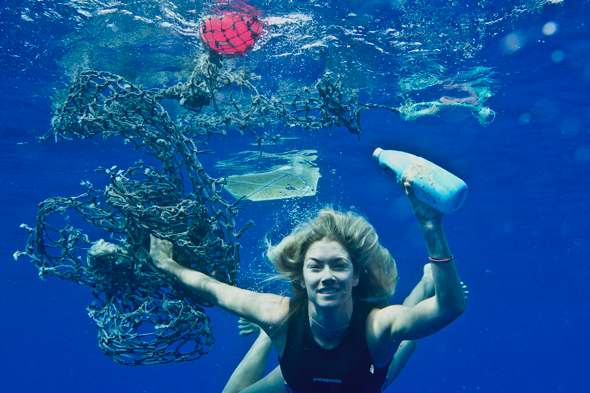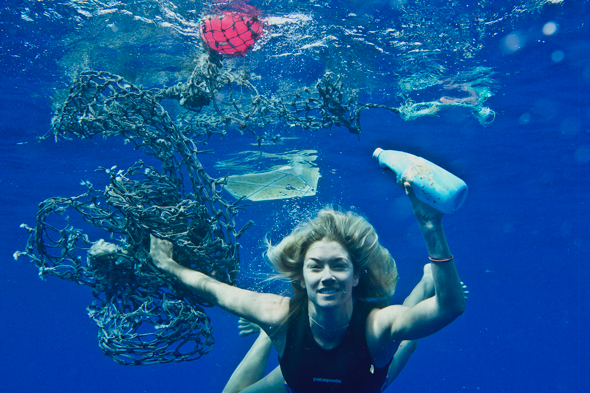
By Lisa Bland —
Anyone who has spent time on or near the ocean knows its power and beauty, and has probably been touched by its mystery. Seeing first hand a whale breaching from the depths, schools of dolphins and swirling silver fish, or discovering tide pools filled with urchins, anemones, and hermit crabs, inspires fascination and wonder. Time spent on beaches is time merging with the ebb and flow of the tide as the grip of modern living loosens its hold. Yet our oceans increasingly bear the mark of today’s world. It seems the immensity of the sea could swallow all trace of our human impact, but with a closer look, it couldn’t be further from the truth.
When I was a child, we lived near the ocean on the islands of Haida Gwaii and our playground was the seashore. Jellyfish blobs, skeletal bits of white coral, pink crabshells, moonsnails, periwinkles, purple seaweed, and driftwood formed an endless procession of fascinating diversity where the tideline left its mark. Each day the treasures were different and the quest to find a rose agate, sand-dollar, or perfectly whole urchin shell kept us walking miles and miles to see what lay ahead. Interspersed among nature’s treasures were bits of the modern world—bottle caps, frosted glass, small floats, netting, rope scraps, straws, and Styrofoam pieces. Finding elusive glass balls that washed up from Japanese currents was celebrated and rare. I’m not sure when I noticed, but over time, plastic became more prevalent on our beaches. Trips to outer islands on the West Coast in direct line with the swells of the open sea revealed beaches littered with debris, high into the forest where the surf pounded with raging southeasterly storms. Plastic became embedded in the soil and the high tide line. Today, it not only permeates the habits of our consumption on a grand scale, it is also woven into the tiniest micro threads of the fabric of the world we inhabit.
Have you ever tried to live one day without plastic? It is challenging and frustrating. Everywhere we go, in every part of society, plastic goes too. Rejecting plastic goes against the grain, and accepting it without question is often about social graces. It’s hard to say no to that plastic wrap, extra plastic bag, straw, or to-go container when it’s handed out with a smile. Some escape plastic use in daily life by buying in bulk, reducing purchases of packaged items, using reusable bottles, saying no to bags in the store, or refusing to-go containers when eating out—but the reality is, we’re awash in the stuff. Waste management practices in the developed world give us options for recycling plastic items so it may not appear that we’re literally swimming in it, but all it takes is travelling to a Third World country to see how ineffective we are at handling plastic and keeping it out of our ecosystems. Our oceans have become the final dumping ground, and a trip to any beach across the world tells the story.
Through sunlight and wave action, these tiny bits of petroleum products are broken down, but never completely disappear.

So, what do we know, and what can we do about this all pervasive plastic problem? A global team of researchers who blend science, education, and activism in a nonprofit group called 5 Gyres are working to stem the tide of single-use plastics and end ocean plastic pollution. Through researching aquatic plastic dispersal, they are defining the extent of the problem—and through education and activism, they are working on solutions by promoting changes in product design and policies. Led by co-founders, Anna Cummins and Marcus Eriksen, over the past five years, 5 Gyres has embarked on sea expeditions around the world studying the five main subtropical gyres in the Indian Ocean, North Atlantic, North Pacific, South Atlantic, and South Pacific.
Each gyre is a spiralling vortex of current on the surface of the ocean and is generated primarily by the global wind system and rotations of the earth. 5 Gyres discovered that ocean gyres churn up plastic into smaller and smaller pieces like blenders or shredders. Through sunlight and wave action, these tiny bits of petroleum products are broken down, but never completely disappear. They become microplastic particles, expelled from the gyres and carried by sea currents and deposited on beaches throughout the world.
While people may think of islands of plastic floating in the ocean as retrievable garbage patches, it’s a myth. In a recent article in the magazine, Organic Life, Eriksen says the discovery of the Great Pacific Garbage Patch in the late 90s created a lot of media hype and has been both a blessing and a curse. It brought more awareness and funding to deal with plastic pollution, but gave the false impression that plastic is gathered up in large pieces and is easy to remove. Many expensive cleanup projects didn’t pan out. Despite its enormous size and density, the patch consists mainly of suspended particles in the upper water column. Eriksen describes this plastic pollution more like an underwater plastic smog. Our sewers, storm drains, and rivers can be likened to “horizontal smokestacks” carrying to the ocean the plastic we throw away. Much of the plastic sinks to the ocean floor or washes up on beaches, but the remaining floating plastic is carried out to sea, where ocean currents swirl much of it into the gyres.
5 Gyres advocates for better litter laws, public education, improved waste management, and most importantly, consumer and extended producer responsibility.”
Using specialized collection instruments or trawls that skim along the surface of the ocean dragging behind the ship, 5 Gyres researchers analyze and collect plastic particles floating on the surface. They have compiled the first estimate of the weight and count of plastic floating worldwide. Eriksen’ s December 2014 published scientific report estimates a total of 270,000 metric tonnes and 5.25 trillion particles floating in the world’s oceans, 92 per cent of which are microplastics. To get an idea of the magnitude of this much plastic, if you strung a line of 2L plastic jugs end to end they would reach the moon and back twice.
Most of the plastic found at sea is a combination of polyethylene, found in bags and bottles, and polypropylene, as found in bottle caps, fish nets, and straws. These bits of plastic also pull in and concentrate waterborne contaminants such as pesticides or flame retardants, and can be highly toxic. Ocean creatures such as fish and shellfish may ingest these particles, which bio-accumulate in the food chain and inevitably get passed back into humans. Plastic harms other marine life such as birds, mammals, and turtles that may become trapped or entangled.

The crux of the problem is us. We currently throw out 90 – 95 per cent of all the plastic we produce. Half of this plastic waste is buried in landfills, and much of it washes out to sea. The disposable plastic products we buy and how we deal with plastic waste is in our control and 5 Gyres is working hard to improve public awareness of the problem, and is lobbying for change at corporate and political levels. Take microbeads, for example. Ever notice the small blue bits in your toothpaste or skin care products? They’re a combination of polypropylene and polyethylene plastic about 1/3 mm in size. One tube of facial scrub may contain up to 300,000 particles. They are completely unnecessary, and these tiny round particles can bypass sewage treatment systems and are showing up in lakes, waterways, and oceans where they settle into ecosystems and the stomachs of the creatures.
5 Gyres advocates for better litter laws, public education, improved waste management, and most importantly, consumer and extended producer responsibility. Innovations in environmentally harmless design is an area in need of vast improvement. Pressure by 5 Gyres and other groups has resulted in various companies replacing or removing microbeads from their products, but there is still a long way to go.
On a recent leg of their expedition from the Bahamas to Bermuda, on the 167-foot schooner The Mystic, 5 Gyres brought in a mix of people from businesses, the media, music, adventure sports, and advocacy organizations to collaborate and spread the message at many levels of society. Singer and plastic awareness advocate, Jack Johnson, was among the group, along with his film crew documenting their journey and research.
5 Gyres is making a difference on our oceans, and along with gathering never before known statistics about plastic pollution, its members are helping to inspire international awareness, educate youth, create microbead legislation, and restore habitat with international beach clean ups.
You can be a part of the change by signing the 5 Gyres micro bead petition, donating to fund ocean research, getting involved by conducting your own citizen science, or taking part in their other volunteer opportunities. To see more about their programs, research, and actions you can take visit www.5gyres.org.
Read up on Jack Johnson’s top 10 Plastic Tips here: www.allatonce.org/plastic-free-top10.
In your own life, consider if you really need that plastic fork, water bottle, plastic bag, straw, or to-go container. Don’t use products with microbeads. Buy things for longevity and quality, not convenience. Say no to plastic, even if it means a few strange looks or exasperation from service people. Look into the great selection of safe reusable containers such as Kleen Kanteen stainless steel water bottles at www.kleankanteen.com.
Saving our world’s oceans starts with you!

